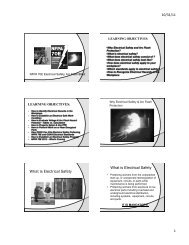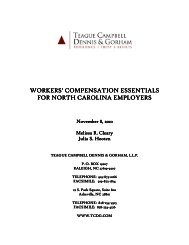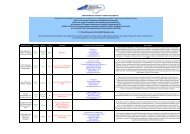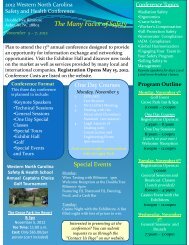Titanic, a Human Performance Case Study :: Presentation
Titanic, a Human Performance Case Study :: Presentation
Titanic, a Human Performance Case Study :: Presentation
- No tags were found...
Create successful ePaper yourself
Turn your PDF publications into a flip-book with our unique Google optimized e-Paper software.
What was the name of the threegiant vessels built by Harland andWolff?• Olympic• <strong>Titanic</strong>• Gigantic
Which one of the three ships hadits name changed?• Gigantic• It would be changed to the BrittanicBrittanic
The <strong>Titanic</strong> was also known asthe RMS TITANIC whatdoes RMS stand for?• Royal Mailing Steamer
TITANIC FACTS• March 31, 1909 construction begins byHarland and Wolff for WHITE STAR LINEin Belfast Ireland.• The ship cost 7.5 million dollars to build.Today’s cost 400 million dollars.• Skilled shipyard workers earned $10.00 perweek.• One First Class ticket would cost 4 to 8months wages.
TITANIC was one of the largestmovable objects ever built.• The ship was 883 feet long, 92 feet wide.• Weighed 46,328 tons.• Was 104 feet high from keel to bridge.• Powered by 3 engines (2 reciprocating, 1turbine), which equaled 46,000 total hp.• Total capacity 3547 people, 2,227 were onboard.
TITANIC a floating city!!Brief description of food supplies on board:• 75,000 lbs. fresh meat• 11,000 lbs. fresh fish• 40,000 fresh eggs• 200 barrels of flour• 2.75 tons of tomatoes• 40 tons of potatoes• 1,500 gals. fresh milk• 20,000 bottles of beer and stout• 1,500 bottles of wine
The <strong>Titanic</strong>’s Hull• Protected by double bottoms.• Separated by 15 “watertight” bulkheadswhich extended half way up the hull.• Bulkheads could be sealed by activatingwatertight hatches which wouldcompartmentalize the hull into 16 differentsections.• As a result the ship was consideredUNSINKABLE.
Trivia Facts• Ship cost 7.5 million dollars.• <strong>Titanic</strong> movie cost 250 million dollars.• <strong>Titanic</strong> sank in approximately 2 hrs. 40 min.• The film <strong>Titanic</strong> runs 3 hrs. 14 min.• It took 3 years to build the <strong>Titanic</strong>.• It took approximately 3 years to make thefilm.
FIVE PRINCIPLES OFHUMAN PERFORMANCE1) People are fallible and even the best makemistakes.
FIVE PRINCIPLES OFHUMAN PERFORMANCE2) Error-likely situations are predictable,manageable, and preventable.
FIVE PRINCIPLES OFHUMAN PERFORMANCE3)Individual behavior is influenced byorganizational processes and values.
FIVE PRINCIPLES OFHUMAN PERFORMANCE4) People achieve high levels of performancebased largely on the encouragement andreinforcement received from leaders, peers,and subordinates.
FIVE PRINCIPLES OFHUMAN PERFORMANCE5) Events can be avoided by an understandingof the reasons mistakes occur andapplication of the lessons learned from pastevents.
5 Principles / 6 Techniques1) People are fallible and even thebest make mistakes.2) Error-likely situations arepredictable, manageable, andpreventable.3) Individual behavior is influencedby organizational processes andvalues.4) People achieve high levels ofperformance based largely on theencouragement and reinforcementreceived from leaders, peers, andsubordinates.5) Events can be avoided by anunderstanding of the reasonsmistakes occur and application ofthe lessons learned from pastevents.• Self-Check (STAR)• Questioning Attitude• Pre-Job Brief• Procedure Use andAdherence• Positive Reinforcement• Operating Experience
OBJECTIVES Identify the sequence of events that led tothe fatal shipwreck of the <strong>Titanic</strong>. Determine the contributing factors of theevent. Identify the practices that should haveprevented the event. Identify <strong>Human</strong> Error PreventionTechniques and practices used to preventsimilar events .
Harland and Wolff build twomammoth passenger liners!• <strong>Titanic</strong> and the Olympic were built at theHarland and Wolff shipyard in BelfastIreland, for the White Star line.• <strong>Titanic</strong> slipped from her Belfast dry dock onMay 31, 1911 and was towed to her fittingout basin for completion.• The <strong>Titanic</strong> was fitted out in a little over tenmonths and left Belfast on April 2, 1912 forsea trials.
<strong>Titanic</strong> was declared sea worthyafter a little over eight hours of seatrials.• Sea Trials are designed to prove capabilitiesof equipment, crew, and procedures duringboth normal and abnormal conditions.• Only one life boat drill was conducted andseveral members of her crew of nearly 900would not report on board until the day ofdeparture.
<strong>Titanic</strong>’s Maiden Voyage• <strong>Titanic</strong> left Southampton, April 10 1912,first stop Cherbourg, France, final,destination New York.• Scheduled 7 day voyage.• <strong>Titanic</strong> was commanded by Captain EdwardJ Smith.• Ironically, he expected this to be his lastvoyage and crowning achievement.
Five years prior to the <strong>Titanic</strong>, Captain Smithcommented on the technology in the shippingindustry.• “I will say that I cannot imagine anycondition that would cause a ship to founder… Modern shipbuilding has gone beyondthat.”
<strong>Titanic</strong> witnessed close call whileleaving port!• Suction created by her passing caused theNew York to break loose from pier andswing dangerously near her path.• Seven months prior, her sister ship, the• Seven months prior, her sister ship, theOlympic passed the HMS Hawke, drawingit into its side causing damage to bothvessels.
<strong>Titanic</strong> alters course!• The arctic winter was unusually warm andice had been reported at lower latitudes thannormal.• <strong>Titanic</strong> would proceed on a more southerlyroute.• Other than this minor change, the first daysat sea were uneventful.
Sunday night April 12th<strong>Titanic</strong> was steaming into an area ofreported ice!• <strong>Titanic</strong> speed was over twenty-two knots.• Air temperature was dropping and belowfreezing.• Marconi operators received ice warningsfrom four different vessels.• Warnings were passed on to Captain Smith.• Only one warning was posted in the chartroom for officers’ information .
Iceberg Detection• Radar and Sonar were unknown of in 1912.• Icebergs could only be detected by vigilantobservation by the crew.• Light reflected by the surface or wavessplashing against the base of the berg werethe only signs of ice in the water.• With no moon and a dead calm sea, theseindicators were absent.
Change of command on bridge!• At 9:20 P.M., Captain Smith left SecondOfficer Charles H. Lightoller in command.• Smith’s instructions were, “If in theslightest degree doubtful, let me know”.• 9:30 Marconi operator received a wirelessmessage from the Mesabe warning of packice and large icebergs in the <strong>Titanic</strong>’s path.• The message was not forwarded to CaptainSmith or the bridge.
10:00 P.M. Second Change ofCommand takes place on the bridge.• Second Officer Lightoller turned commandover to First Officer William Murdoch.• Murdoch was advised that they would comeinto the reported ice at about 11:00 P.M.• Watch relief in the crow’s nest alsooccurred at this time.
Californian sends wireless messageto <strong>Titanic</strong>!!• Californian stated “Say old man we arestopped and surrounded by ice”.• <strong>Titanic</strong> replied “Shut up! Shut up! I amworking Cape Race.” <strong>Titanic</strong> was trying tobeat the record set earlier by sister shipOlympic.• The Californians report was neverforwarded.
11:35 Huge Ice Berg was discovered!• Immediately the crow’s nest rang the belland reported huge ice berg ahead.• At nearly the same time First OfficerMurdoch saw the berg and ordered “Harda’starboard!” and “Full speed astern!”• These orders were intended to slow thevessel and steer to the left of the ice.• At 11:40 Murdoch then ordered “Harda’port!” in an attempt to swing the sternclear.
“Knight’s Seamanship”The Ruling Seamanship Manual• States that striking head-on with the bowwas far more desirable then an obliquestrike, should a collision be unavoidable.
A Seaman’s Worst Nightmare!!• At 11:40 the vessel grazed the ice, hullplates ripped open along a 250 to 300 footsection.• This opened the the forward sixcompartments of the ship to the sea.• Perhaps no more than twelve square feet ofhull surface was opened, but the damagewould begin dragging the <strong>Titanic</strong> down bythe bow.
Ship’s Chief Architect, ThomasAndrews inspects damage!• Andrews after learning of flooding in sixcompartments, reported to Captain Smiththat the ship had only a short time to live.• 12:10 AM on April 15, Captain Smithordered Marconi operator to send out a“CQD”, Calling Distress.• Many on board including some officerswere not aware that the ship had struck anice berg.
Carpathia answers distress signal!• From approximately 60 miles away theCarpathia responded to distress signal.• The Californian, who was possibly 5 to 18miles away failed to answer.• She had shutdown for the night in heavy iceand the Marconi operator was no longer athis station.
Lifeboat operation progressedslowly and with significantconfusion.• Only 16 regular lifeboats and 4 collapsibleboats were on the <strong>Titanic</strong>.• This was only half the lifeboats that wasneeded for the passengers and crew.• <strong>Titanic</strong> had capacity for sixty lifeboats.• British Board of Trade regulations did notrequire vessels to carry enough lifeboats forall on board.
Lifeboats• Passengers did not realize the danger andwere slow to get to the lifeboat stations.• Ships officers were unfamiliar with lifeboatdavits and their capacities.• Most lifeboats were half full when theywere lowered into the water.• Crew members were unfamiliar with smallboat handling and had to be taught how torow by passengers.
Mystery Ship Spotted!!• Shortly after midnight, Fourth OfficerBoxhall sighted the mast light of anothervessel, apparently a steamer.• His Morse signals would go unanswered.• At 12:45 A.M. Quartermaster Rowe beganfiring distress rockets at five minuteintervals.
Could it be the Californian?• Even though distress rockets had beensighted by the Californian and reported toher captain, Stanley Lord, they wentunanswered.• Captain Lord, upon hearing of the signals,ordered the Morse lamp manned.• With no response Captain Lord did notinvestigate the rockets nor did he re-stationhis Marconi operator who had secured at11:35 P.M.
Even today it is unknownwhether the mast lights sightedwere those of the Californian oranother ship in the area - possiblythe Norwegian Samson,operating illegally in the area forseals.
The <strong>Titanic</strong> Sinks• The bow sank and the stern rose into the air.• The ship broke in half with the stern settlingback into a horizontal position for a fewmoments.• The bow drifted to the bottom, two and onehalf miles below, followed by the stern.• Passengers still on board either jumped orwere thrown into the 33 degree water.
By 3:30 A.M. the Carpathia arrivesat the scene!• The Carpathia began picking up lifeboats.• At 8:50 A.M. she headed for the New Yorkharbor.• The Californian, after learning of theaccident, had arrived at the scene andremained in the area searching forsurvivors.• No others were found.
Carpathia arrived in New York,Thursday evening April 18, 1912.• Of the 2,227 enthusiastic passengers, only705 would survive.
THANKS !!!!!!!HOLLANDPERFORMANCECONSULTING704-650-3687







